Grafting tomatoes (and peppers, eggplants, potatoes)
Grafting tomatoes (and chillies, peppers and eggplants) is a good way to increase plant production while reducing the risk of diseases and pathologies linked to the root system. Increased vigour, higher yields and no more problems of apical necrosis (the famous » black arses « ). Here’s a simple explanation of the different techniques for grafting tomatoes, the choice of rootstock and which varieties to graft.
Why graft tomatoes?
- To increase yield (especially on fragile, low-yielding varieties such as the zebra pineapple tomato or the Everett’s Rusty Oxheart)
- To increase plant vigour (as in the case of certain delicious but slow-growing tomato varieties such as the black pineapple).
- To reduce problems related to the root system (such as apical necrosis on elongated tomatoes like Cornue des Andes or San Marzano
- To reduce root diseases (such as corky root disease, or fusarium on tomatoes or melons)
- To optimize space in small vegetable gardens or greenhouses where space is limited
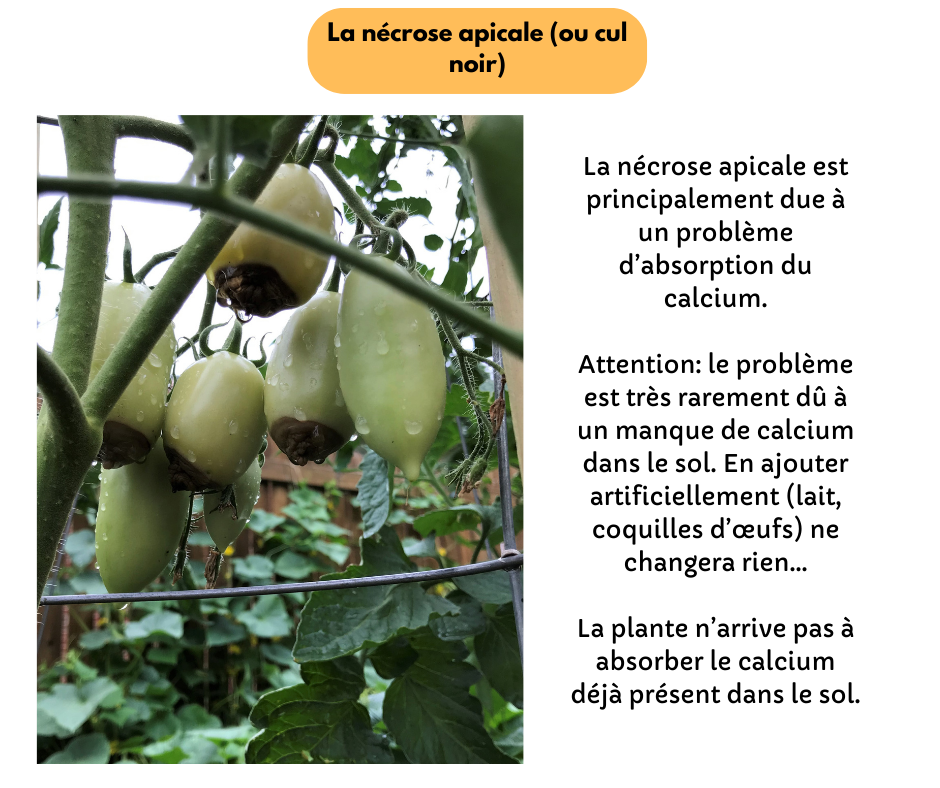
Why graft eggplants and peppers?
If you live in a cold climate, you’ll have noticed that eggplants stagnate for a long time after planting… This is normal, as eggplants require a high soil temperature to start growing. By replacing the root system of an eggplant with that of a tomato, you benefit from all the advantages of the tomato (vigor and lower temperature requirements), without the disadvantages of the eggplant. This considerably increases eggplant yields.
Which vegetables can be grafted?
You can also graft all types of cucurbits. One of the most common grafting techniques is to graft melons onto squash and watermelons onto squash. In both cases, the results are spectacular in terms of production. This grafting is very effective in protecting against fusarium wilt of melons.
Greek basil (very slow-growing) can be grafted onto Crimean basil (very vigorous). For further information, please read our complete guide to growing basil)
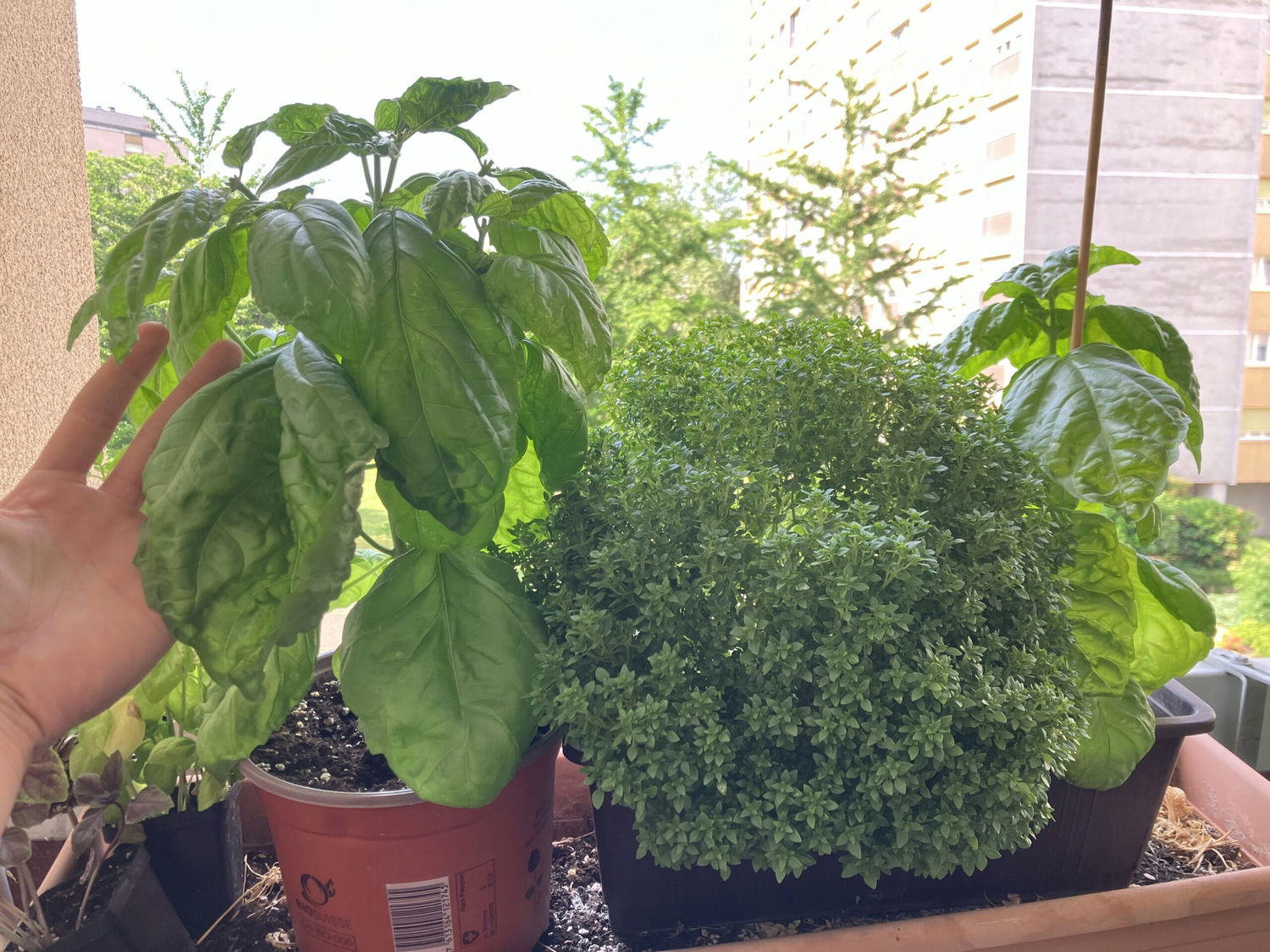
Isn’t grafting natural?
« You’re doing permaculture and grafting tomatoes? But that’s not natural! »
The graft, or anastomosisgrafting, or anastomosis, is a natural process, not very common in nature, but quite possible. This is known as aerial anastomosis or root anastomosis (which is more common). Anastomosis is an evolutionary advantage that enables plants to pool resources while minimizing the risks associated with excessive growth. (It’s better to link 2 trees of 20m than to have a single tree of 40m, which is more exposed to storms).
So yes, grafting is natural, although in nature eggplants don’t graft themselves onto tomatoes… (at the same time, is it really « natural » to grow tomatoes in Switzerland…)


Oak anastomosis (image by phototheque.enseigne.ac-lyon.fr )
History of transplantation
Human beings didn’t invent anything; they used observations to reproduce this principle for their own uses. The first written records of tree grafting date back to China in the 2nd century BC. The method was then imported to Europe in antiquity. The Greeks and Romans played a major role in developing and disseminating grafting.
In the 19th century, Lucien Daniel developed grafting techniques and began to transpose them to vegetables.
Choice of rootstock
We recommend rootstocks with high vigour and/or varieties resistant to soil-borne diseases or apical necrosis.
Today, specific varieties have been developed for use solely as rootstocks, such as :
- Ground force F1 (Vigorous with little space between fruits)
- Protector F1 (vigorous and resistant to fusarium)
- Arnold F1 (Vigorous and resistant to nematodes and corky root)
- Brutus F1 bell pepper (for pepper/pepper transplants)
- Capsifort F1 (for pepper/chilli grafts)
- Ultron F1 bell pepper (for pepper/pepper transplants)
Reproducible rootstocks :
- Little sparrow
- Viollet Jasper
Yes, they are F1 hybrids (even if we’re not a fan of the concept…), because in addition to the selected genetics (vigor and resistance), being an F1 it has the heterosis which adds even more vigor to the plant. Unfortunately for gardeners, these seeds are not stable and you can’t produce them yourself (all the more so as there are patents registered on them which forbid their reproduction).
Tomato grafting on the Petit moineau variety
The petit moineau tomato is a farmer’s variety (which means it can easily be reproduced identically), it is very vigorous and insensitive to apical necrosis. It could make an ideal candidate for grafting, but…it’s far from perfect.
Indeed, it has a very fine stem diameter, which complicates grafting work and the timing of sowing to obtain equal diameters between the rootstock and the scion.
In short, it’s a good way to get started at low cost, but once you’ve mastered the techniques, we strongly advise you to use other graft holders.
If you want to graft without buying F1 seeds, you can simply use the most vigorous variety (if possible, a cherry tomato variety) of your tomatoes as rootstock. (We tend to use the Viollet Jasper variety).
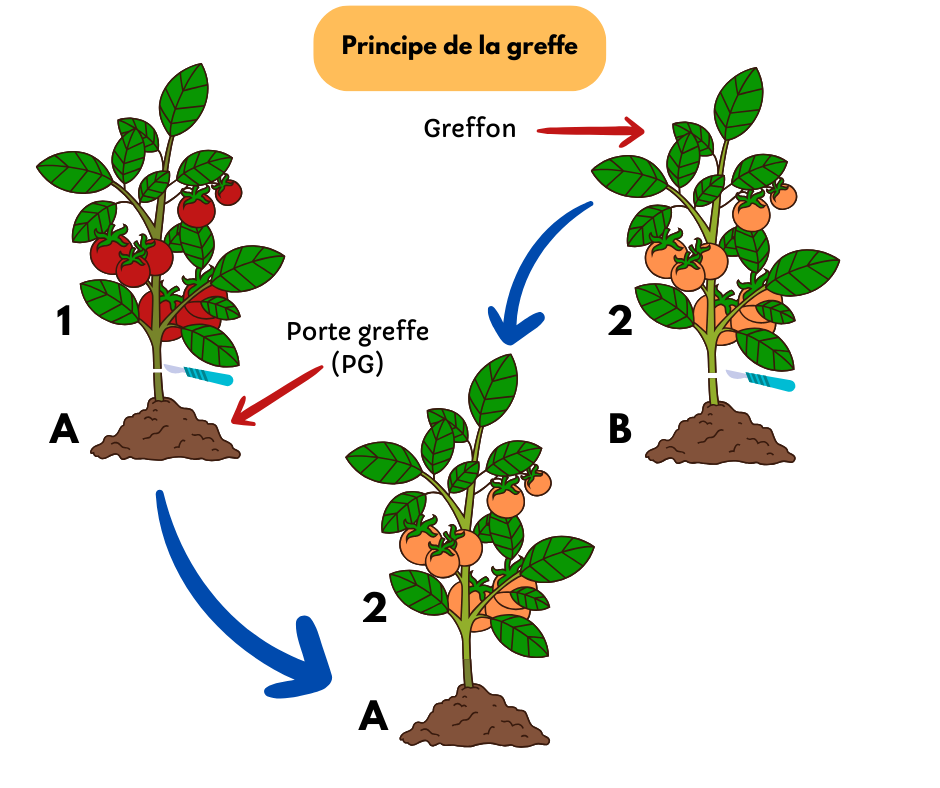
Choosing varieties for grafting
We strongly recommend grafting horned and elongated tomato varieties (and in general all those susceptible to apical necrosis) such as the Cornue des Andes variety, San Marzano or Tulip yellow
Other varieties to be grafted are the excellent and less productive varieties such as black pineapple tomatoes, Jaune du Lac de BretOn these varieties, yields can be multiplied by 3 compared with ungrafted plants.
To put it simply, all the varieties in our » the best tomatoes « are good candidates for grafting
And, of course, just about every variety of eggplant.
Is it possible to graft cherry tomato varieties?
Yes, but there’s little point… cherry tomatoes are generally quite vigorous and not very susceptible to black-bottom… so there’s little point in grafting cherry tomatoes.
Compatibility and benefits
All plants in the Solanaceae family (tomatoes, peppers, eggplants, potatoes and cape gooseberries) are suitable for grafting. However, some mixtures are more suitable than others. For example, there’s no point in grafting a tomato onto an eggplant (whose root system is rather weak…).

Materials required
- Grafting and rootstocks
- Scalpel or cutter
- Disinfectant
- Grafting forceps
- Containment area (plastic storage box or bottle cut in 2)
- A cutting guide (optional)
- Drill bit (for toothpick grafting)

Grafting methods
The different grafting methods are described below. The choice of technique depends on several factors:
- Size of available grafts/carriers
- The availability of a containment zone
- Your habits and preferences
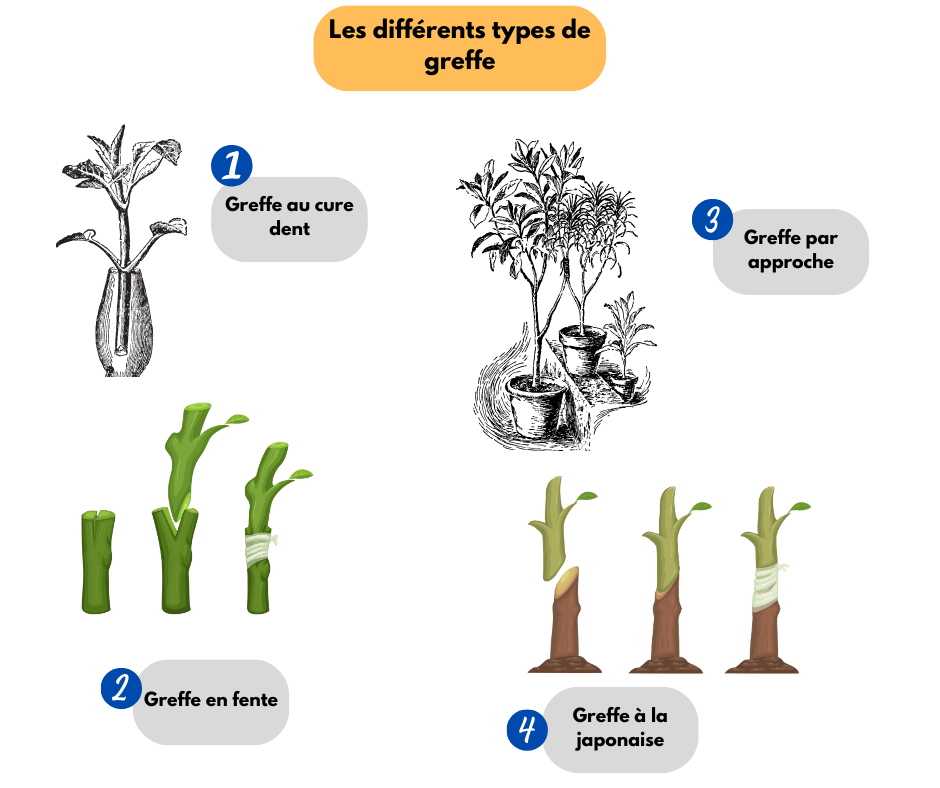
Japanese tomato grafting
This is the most effective method (for us). It consists of making a cut, either straight or at a 45° angle (we recommend the 45° angle cut) on the graft and the PG. The graft is then placed on the rootstock.
WARNING: the 2 parts must be of the same calibre to increase your chances of success.
We recommend :
- Cut the rootstock at a 45° angle (below the cotyledons to avoid sprouting).
- Place the clamp on the PG
- Cut the graft (above the cotyledons)
- Incise the graft by opening the existing forceps to place it on the PG
- Confinement for 15 days
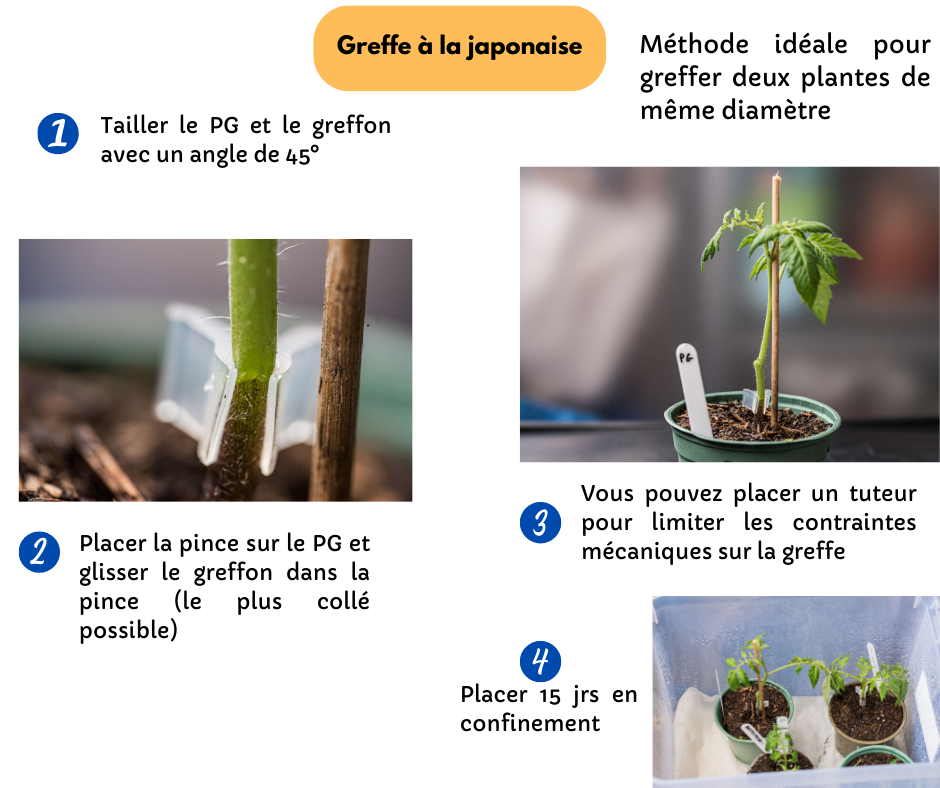
Slotted tomato grafting
This is the same technique used for grafting trees. This technique makes it possible to graft plants of different diameters. It also allows 2 grafts to be slipped into the rootstock to make tomatoes with several varieties (but the success rate is much lower with 2 grafts).
Procedure:
- Cut off the PG head (below the cotyledons if possible)
- Make a vertical slot about 5 to 7mm long
- Cut the graft at a double bevel
- Slit-cut the 2 sides of the graft to expose as much cambium as possible (the area used for welding).
- Add clip
- Confinement for 15 days
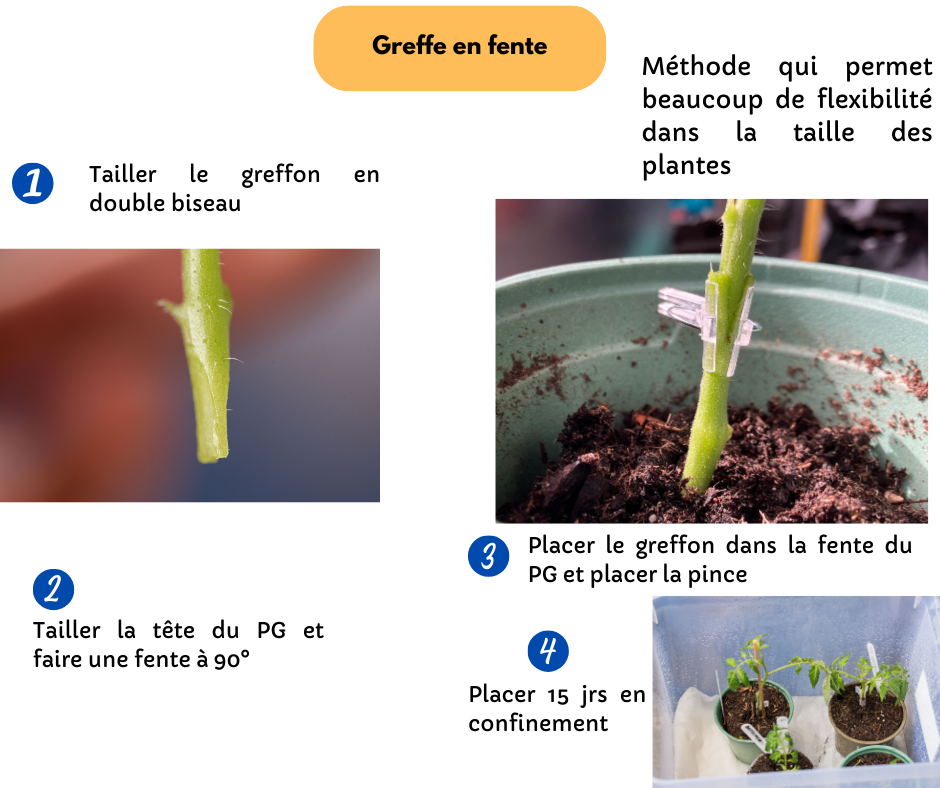
Grafting tomatoes with a toothpick
This method is very practical for grafting plants of very different sizes. This is almost always the case when you want to graft eggplants onto tomatoes.
Procedure:
- Cut off the PG head (below the cotyledons if possible)
- Make a hole with the drill bit (diameter 1.5 or 2mm) about 5 to 7mm vertically.
- Cut the graft to a point (like a pencil)
- Add clip
- Slide the graft into the hole in the PG, opening the clamp already in place.
- Confinement for 15 days
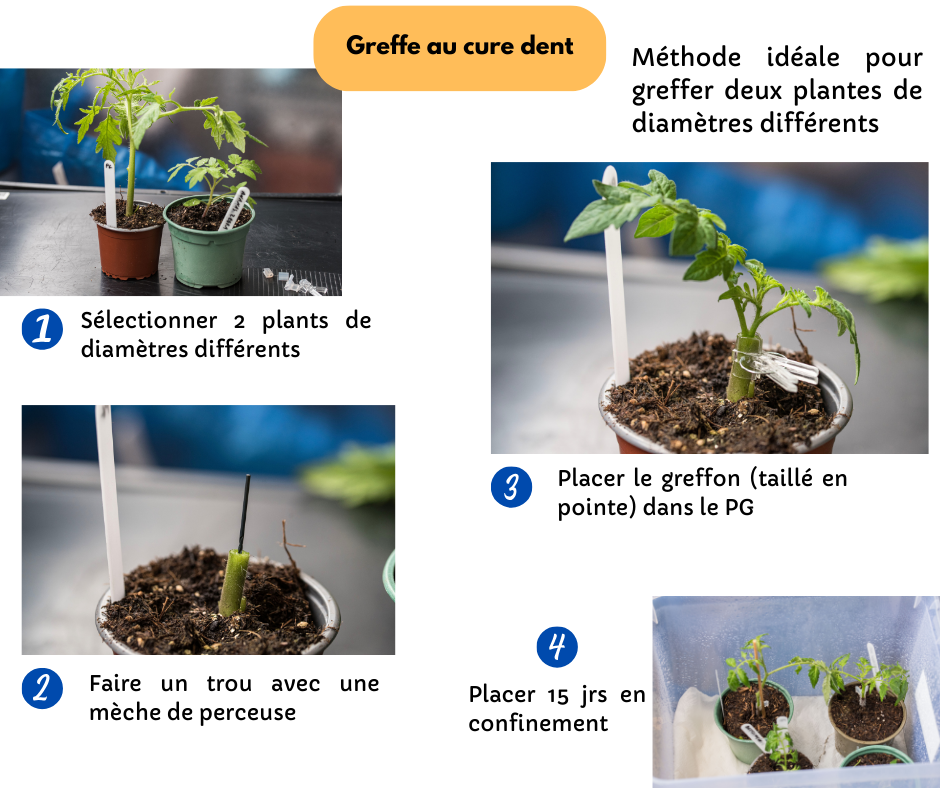
Approach grafting
In our opinion, this is the easiest method for beginners to use. Even if handling requires a little more dexterity and precision. It can be used to graft plants of different sizes, but above all it’s the only grafting method that doesn ‘t require confinement.
Procedure:
- Make a 75° or 80° notch in one direction on the PG
- Make a 75° slit about 5 to 7mm in the other direction on the graft
- Slide the tip of the graft into the slot of the PG
- Add clip
- Place plants in the same pot
- Wait 15 days (unconfined)
- Cut the base of the graft so that the graft is fed only by the PG.

Containment phase
This is the key to successful grafting! The critical moment for all grafting methods (except approach grafting).
Deprived of circulation between leaves and roots, the plant will tend to dry out if left unattended. The idea is therefore to place the plant « à l’étouffée » in an area saturated with humidity(hygrometry close to 100%) to prevent it from sweating and drying out. To do this, place a wet towel on the bottom and spray water on the plants and walls before closing the container.
Important: The temperature in the containment area must be between 24 and 26°C.
This moist area should also be kept out of direct light. As the days go by, and the wound heals, the confinement will be progressively lightened.
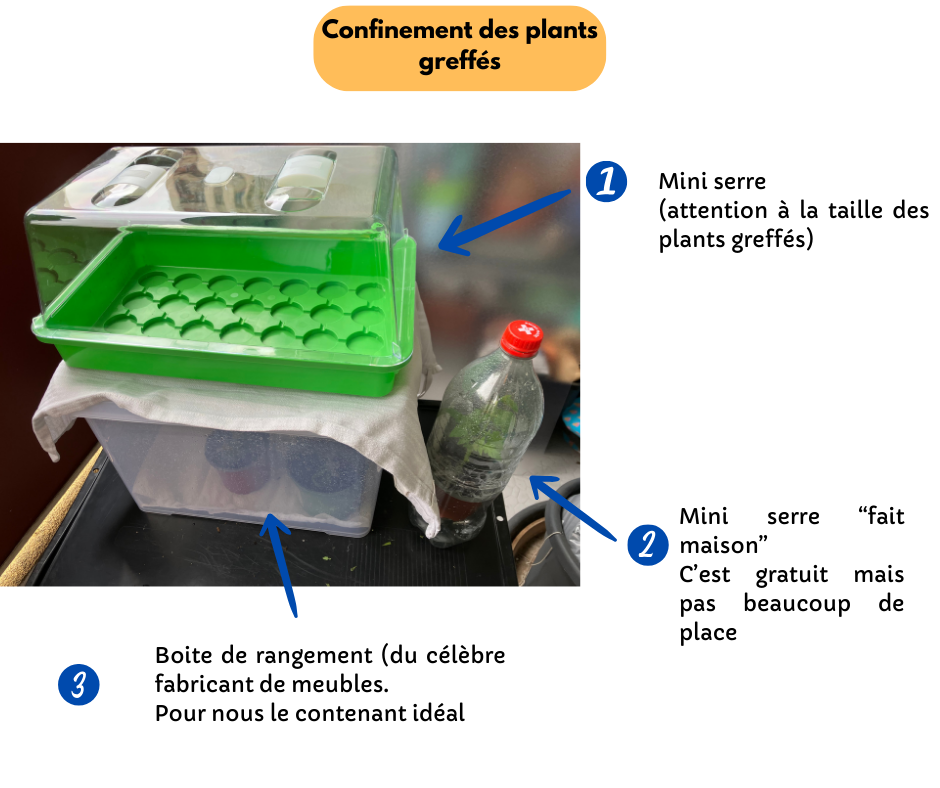
- The first days, D1 to D4
Spray the leaves and walls of the box.
Place a cloth over the can to limit light.
Do not open can
- J5 to J7
Open the box 10 minutes a day
- D8 to D15
Open the box for 30 minutes, then 1 hour the next day, then 2 hours the day after…
- D15 to D20
Remove plants from confinement and place in half-shade
- J20
Place the plants in the sun. Normally, they shouldn’t look too good… which is logical after such a treatment. But don’t worry, they’ll soon pick up again and overtake the ungrafted plants.
Grafting 2 different tomato varieties onto the same plant
It’s not easy, it’s time-consuming and it’s not very useful… But it’s fun and it’s possible. You have 3 options:
- Do a Japanese-style graft, then in a second step, do an approach graft over the top.
Or
- Make a double graft by approaching the 2 varieties on the PG. When the graft has healed, cut off the head of the PG.
Or
- Do a slit graft, either with 2 grafts in the same slit, or make 2 slits on the PG to place 2 grafts (WARNING, this is by far the method that will give the least results).

Another method for making double tomatoes (without containment)
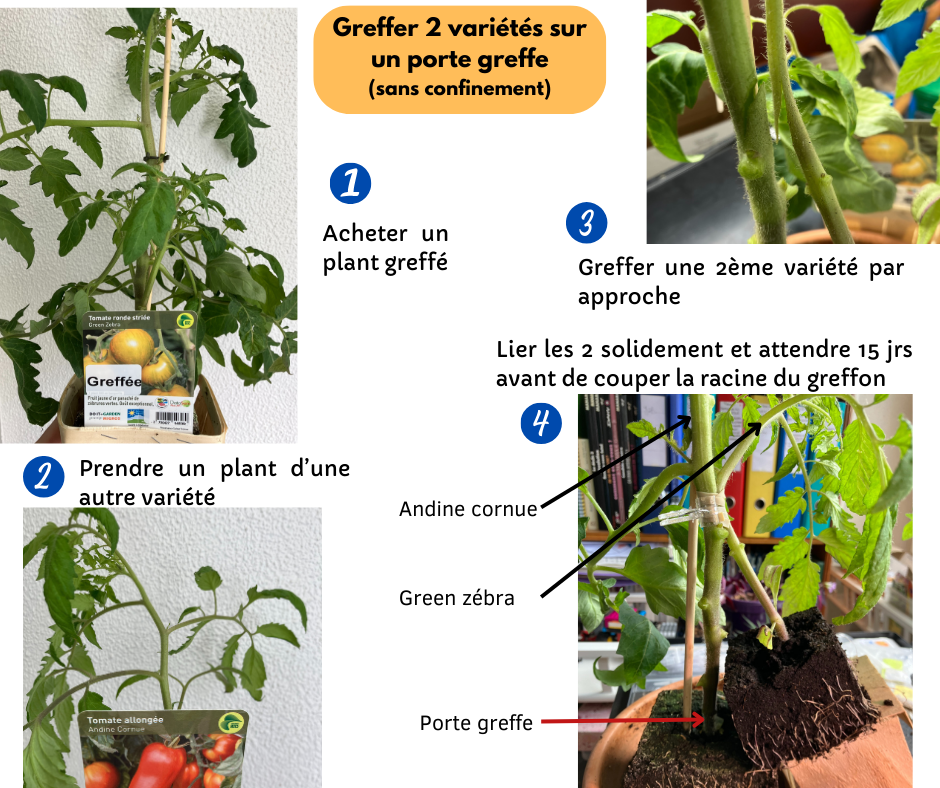

Andean cronu tomato grafted (approach grafting) onto a green zebra tomato. All grafted onto a Protector F1 tomato (Japanese-style grafting). 2 varieties on the same plant with excellent yield and no apical necrosis.
When to transplant tomatoes?
It depends… But allow around 4 to 5 weeks between grafting and planting. So for plants that will go into the greenhouse in mid-April, you can start grafting in mid-March. (and therefore sow between mid and late February).
For plants that will go outdoors in mid-May, you can do the grafting up to mid-April (for seedlings sown in mid-March).
In any case, our trick is to have grafts and PGs of the same size at the time of grafting. We sow the grafts, and when they sprout, we sow the PGs (which grow faster and will catch up with the grafts).
Advice
- Do not shake grafted plants, even after 20 days, as healing is not yet complete. Plants may break
- Do not remove the clamp! They are designed to fall off on their own as the stem thickens.
- Write down the dates! (on the pots, but also in a notebook for next year’s reference)
- Don’t be discouraged if you have mixed success after your first attempt.
- Buy different sizes of pliers
- When you cut off the head of PG, you can take a cutting in a glass of water for later grafting (but beware of the increased risk of rejection).
- Be careful not to bury the grafting point when planting, as the graft will emit roots and separate from the PG.
Transplants and preconceived ideas
- Grafted tomatoes produce bigger fruit
Not really… but it helps to have homogeneous sizes (lots of large fruits on tomatoes that are supposed to make large fruits).
- Grafted tomatoes are more resistant to drought
No and yes…. The root system of a grafted plant is more powerful, and therefore explores the soil better. So yes, to a certain extent, but nothing significant.
- Grafted tomatoes are more resistant to mildew
No, the PG’s resistance comes from the root. Tomatoes grafted on « resistant » PGs are just resistant to soil-borne diseases. Not to mildew.
On the other hand, in the event of an early attack of mildew (such as after heavy rains in June), the more vigorous grafted plants resist light attacks rather well. But at the end of the season, the grafted plants fall ill at the same time as the others.
- Grafted tomatoes are earlier
Yes and no… here too, the ripening time of the fruit is inscribed in the graft’s genetics. However, a grafted plant is better able to produce fruit on several branches.
- Grafting changes the taste of tomatoes
No, taste is defined by the graft.
- For an approach graft, is it useful to leave the 2 roots?
Having 2 roots will not double your harvest… nor will it double the number of roots (which is proportional to the aerial volume of the plant). The risk of root disease will increase if you keep the graft root. So it’s a bad idea to cut off the graft root.
- Commercial grafted plants are too expensive
Grafting vegetables (as well as trees) requires handling, skill, space and the risk of loss. All this comes at a cost. Personally, we’d rather put more money into a grafted eggplant and have a plant that bears fruit, than an ungrafted plant that produces very little. The same goes for tomatoes, which may produce nothing because of black arses.
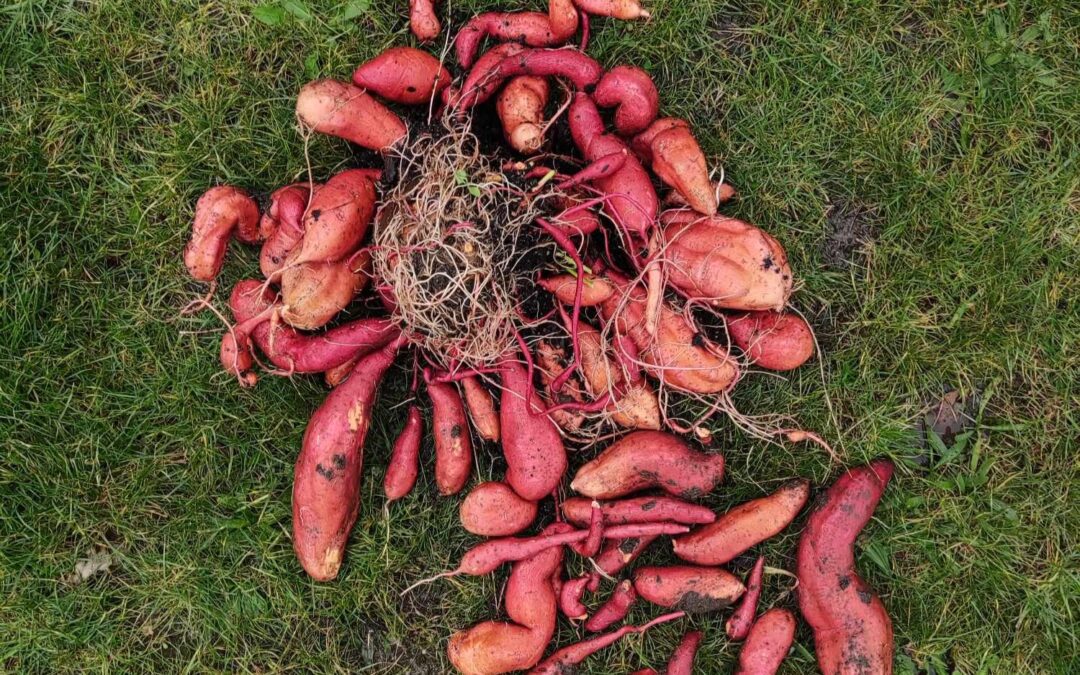
Cultiver la patate douce. Le légume idéal pour les jardins en permaculture !
Cultiver la patate douce, un jeu d'enfant! Dans cet article, on vous dit tout sur ce légume ultra productif! Origine, culture, récoltes, on vous dit tout sur ce légume idéal pour les potagers en permaculture et/ou sur sol vivant.Cultivée dans de bonnes conditions, un...
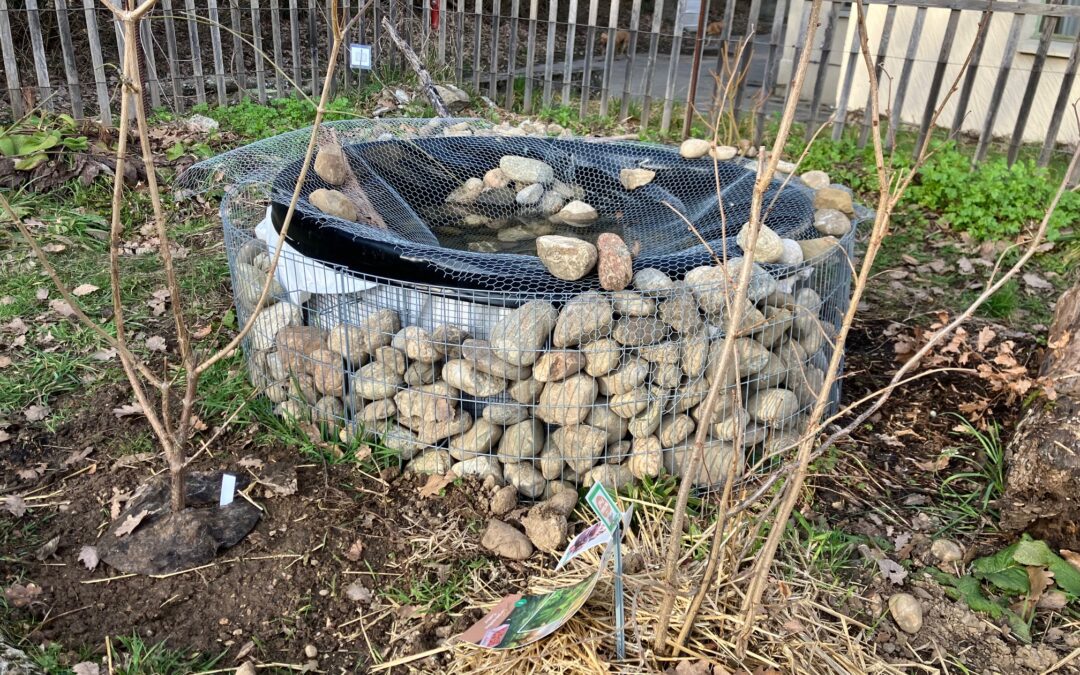
Créer une mare dans son jardin
Vous souhaitez aménager une mare dans votre jardin mais vous ne savez pas exactement comment vous y prendre ? Quelle est la profondeur minimum, quel matériau utiliser pour installer son bassin, ou quelles plantes installer? Nous répondrons à vos questions dans cet...

Construire et utiliser un lombricompost
Le lombricompost : miracle agroécologique! Vous êtes à la recherche d’un amendement organique de sol, qui va à la fois rajouter à votre sol des bactéries bénéfiques, des nématodes, des champignons, des protozoaires, tout en augmentant la biodisponibilité de certains...

